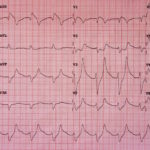Hyperkalemia on ECG
History of present illness:
A 34-year-old diabetic female presented to the emergency department with chest pain status-post AICD firing. She described the pain as a “12 out of 10” which woke her from sleep at 0200, one hour prior to arrival. Vitals were unremarkable. She had no known history of renal failure. Due to frequent ED visits for chronic pain, patient had difficult vascular access and nursing was initially unable to obtain IV access. An abnormal rhythm was noted on the cardiac monitor, and ECG was ordered.
Significant findings:
Initial ECG shows tall, peaked T waves, most prominently in V3 and V4, as well as QRS widening. These findings are consistent with hyperkalemia, which was promptly treated. Follow-up ECG post-treatment shows narrowing of the QRS complexes and normalization of peaked T waves.
Discussion:
The etiology of hyperkalemia may be due to an acute insult such as crush injury, drug side effect, or in acute renal failure, but may also occur in the setting of a chronic insult such as chronic kidney disease.1 As potassium rises, several abnormalities can be identified on ECG. Initially the T waves become peaked and the QRS complexes widen.2,3 This can devolve into a wide complex rhythm, ventricular tachycardia, ventricular fibrillation, or asystole. Patients may also experience systemic symptoms such as weakness or paralysis.1 In this particular case, labs showed a potassium of 7.6-mmol/L after initial treatment (see repeat EKG). While the incidence of hyperkalemia in the general population is not defined, the incidence in hospitalized patients is 1.3-10%.4-8 Impaired kidney function is the most common risk factor found in 33-83% of affected patients.4,5,8,9 Treatment for hyperkalemia generally includes IV insulin and IV dextrose and nebulized albuterol for intracellular shift of potassium, IV furosemide and IV fluids for dilution and renal excretion of furosemide, and IV calcium for stabilization of cardiac membranes.2,3
Topics:
Cardiology, hyperkalemia, electrocardiogram, ECG, peaked T waves, widened QRS.
References:
- Mount DB. Treatment and prevention of hyperkalemia in adults. In: Forman P, ed. Waltham, MA: UpToDate Inc. https://www.uptodate.com/contents/treatment-and-prevention-of-hyperkalemia-in-adults. Updated Sept 29, 2016. Accessed August 20, 2016.
- Osborn MB. PoIn: Adams JG, Barton ED, Collings JL, DeBlieux PM, Gisondi MA, Nadel ES, eds. Emergency Medicine: Clinical Essentials. 2nd ed. Philadelphia, PA: Elsevier; 2013:1397-1404.
- Petrino R, Marino R. Fluids and electrolytes. In: Tintinalli JE, Stapczynski J, Ma O, Cline DM, Cydulka RK, Meckler GD, eds. Tintinalli’s Emergency Medicine: A Comprehensive Study Guide. 8th New York, NY: McGraw-Hill; 2016:92-111.
- Acker C, Johnson J, Palevsky P. Greenberg A. Hyperkalemia in hospitalized patients. Arch Intern Med. 1998;158(8):917-924. doi: 10.1001/archinte.158.8.917
- Moore M, Bailey R. Hyperkalemia in patients in the hospital. NZ Med J. 1989;102(878):557-558.
- Shapiro S, Slone D, Lewis G, Jick H. Fatal drug reactions among medical inpatients. 1971;216(3):467-472. doi: 10.1001/jama.1971.03180290043005
- Paice B, Gray J, Mcbride D, Lawson D. Hyperkalemia in patients in hospital. Br Med J. 1983;286(6372):1189-1192.
- Evans KJ and Greenberg A. Hyperkalemia: a Review. Intensive Care Med. 2005;20(5):272-290. doi: 10.1177/0885066605278969
- Ponce S, Jennings A, Madias N, Harrington J. Drug-induced hyperkalemia. 1985;64(6):357-370.






